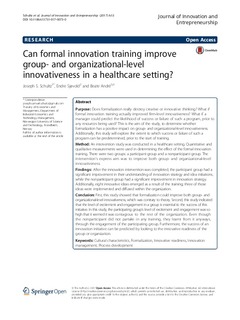| dc.contributor.author | Schultz, Joseph Samuel | |
| dc.contributor.author | Sjøvold, Endre | |
| dc.contributor.author | Andre, Beate | |
| dc.date.accessioned | 2017-10-18T06:58:15Z | |
| dc.date.available | 2017-10-18T06:58:15Z | |
| dc.date.created | 2017-05-21T08:51:01Z | |
| dc.date.issued | 2017 | |
| dc.identifier.issn | 2192-5372 | |
| dc.identifier.uri | http://hdl.handle.net/11250/2460656 | |
| dc.description.abstract | Purpose
Does formalization really destroy creative or innovative thinking? What if formal innovation training actually improved firm-level innovativeness? What if a manager could predict the likelihood of success or failure of such a program, prior to any resources being used? This is the aim of the study, to determine whether formalization has a positive impact on group- and organizational-level innovativeness. Additionally, this study will explore the extent to which success or failure of such a program can be predetermined, prior to the start of training.
Method
An intervention study was conducted in a healthcare setting. Quantitative and qualitative measurements were used in determining the effect of the formal innovation training. There were two groups: a participant group and a nonparticipant group. The intervention’s express aim was to improve both group- and organizational-level innovativeness.
Findings
After the innovation intervention was completed, the participant group had a significant improvement in their understanding of innovation strategy and idea initiations, while the nonparticipant group had a significant improvement in innovation strategy. Additionally, eight innovative ideas emerged as a result of the training; three of those ideas were implemented and diffused within the organization.
Conclusion
First, this study showed that formalization could improve both group- and organizational-level innovativeness, which was contrary to theory. Second, this study indicated that the level of excitement and engagement in a group is essential to the success of this initiative. In this study, the participating group’s level of excitement and engagement was so high that it seemed it was contagious to the rest of the organization. Even though the nonparticipant did not partake in any training, they learnt from it anyways, through the engagement of the participating group. Furthermore, the success of an innovation initiative can be predicted by looking to the innovative readiness of the group or organization. | nb_NO |
| dc.language.iso | eng | nb_NO |
| dc.publisher | SpringerOpen | nb_NO |
| dc.rights | Navngivelse 4.0 Internasjonal | * |
| dc.rights.uri | http://creativecommons.org/licenses/by/4.0/deed.no | * |
| dc.title | Can formal innovation training improve team- and organizational-level innovativeness in a healthcare setting? | nb_NO |
| dc.type | Journal article | nb_NO |
| dc.type | Peer reviewed | nb_NO |
| dc.description.version | publishedVersion | nb_NO |
| dc.source.volume | 6 | nb_NO |
| dc.source.journal | Journal of Innovation and Entrepreneurship | nb_NO |
| dc.source.issue | 13 | nb_NO |
| dc.identifier.doi | 10.1186/s13731-017-0073-0 | |
| dc.identifier.cristin | 1471195 | |
| dc.relation.project | Norges forskningsråd: 212215 | nb_NO |
| dc.description.localcode | © The Author(s). 2017 Open Access This article is distributed under the terms of the Creative Commons Attribution 4.0 International License (http://creativecommons.org/licenses/by/4.0/) | nb_NO |
| cristin.unitcode | 194,60,25,0 | |
| cristin.unitcode | 194,65,20,0 | |
| cristin.unitname | Institutt for industriell økonomi og teknologiledelse | |
| cristin.unitname | Institutt for samfunnsmedisin og sykepleie | |
| cristin.ispublished | true | |
| cristin.fulltext | original | |
| cristin.qualitycode | 1 | |

